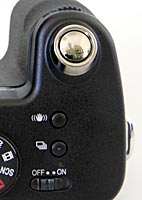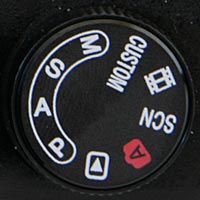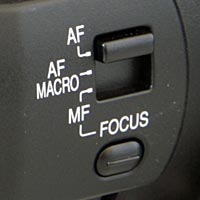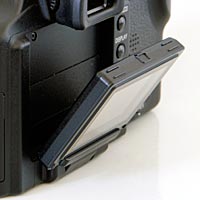Panasonic Lumix DMC-FZ50 Review
Review Date: September 20th 2006
Leave a Comment about this Review
|
Ease of Use
The Panasonic DMC-FZ50 offers a 12x zoom lens equivalent to a focal length of 35-420mm, complete with mechnical zoom and focus rings and a flash hotshoe. Consequently the DMC-FZ50 is quite large, certainly as big as a DSLR with standard lens, but it certainly offers a great compromise between portability (think small camera bag) and handling that will instantly appeal to anyone who has used an SLR camera before. Weighing around 750g with the battery and memory card fitted, the DMC-FZ50 has a reassuring weight, helped by the very prominent, sculpted rubber hand-grip and durable matt-black plastic body. The 12x ultra-zoom, Leica branded lens is obviously the main attraction of this camera, with the giant lens barrel and large 2 inch flip-out LCD screen dominating the overall design. The huge zoom lens obviously makes this one of the most versatile compacts in terms of focal range, especially as it is coupled with Panasonic's Mega O.I.S system, which helps to ensure that the majority of photos taken in good light are sharp. If you're used to a 3x zoom lens, then the 12x zoom will be like a breath of fresh air and should handle most photographic possibilities, with the exception of wide-angle shots.
The one thing that really made the Panasonic DMC-FZ50 great to use was the zoom ring on the lens. After using the various zoom button designs on countless compact digicams, being able to use a "proper" zooming mechanism that works in the same way as on a 35mm SLR lens is a breath of fresh air. I find it much more intuitive, quicker and more precise to use than zoom buttons, and for me personally this would be a big attraction of the Panasonic DMC-FZ50 if I were looking to buy a digital camera. Panasonic have also included a mechanical focusing ring for the Manual focus mode, which again is a much more intuitive way of doing things. The centre of the LCD screen shows a magnified view, and you simply rotate the focusing ring until your subject is sharp. Another great idea are the dual dials for controlling aperture and shutter speed. You use your forefinger to operate the aperture and your thumb to operate the shutter speed. This feature is often found on more advanced DSLR cameras, and is a clear indication of the DMC-FZ50's intentions. It also makes using the Manual shooting mode very easy.
There is no true optical viewfinder, but Panasonic have provided an electronic version, which protrudes from the back of the camera like the EVFs found on many camcorders. The EVF on the DMC-FZ50 is very useful when the LCD screen is difficult to see, for example in very bright sunlight, or when you're using the longer focal lengths, as it allows you to keep the camera steady at the telephoto end of the zoom by holding it up to your eye. This is helped by the lens' quick maximum aperture of f/3.7 at the maximum telephoto focal length of 420mm. I found myself using the EVF almost all of the time, finding it the best way to hold what is quite a heavy camera. There aren't too many weak-points in terms of the DMC-FZ50's design and build-quality. The main disappointment is the inability to twist the flip-out LCD screen, limiting it to use as a waist-level finder, which is more of a design error than a quality issue. In all other respects the DMC-FZ50 is one of the better-made cameras that I've reviewed.
| Shutter Button / Image Stabilisation Button / Burst Mode Button / Off/On Switch | Mode Dial |
 |
 |
Despite offering a full range of manual exposure settings, the Panasonic Lumix DMC-FZ50 is not an overly complex camera in terms of the number of external controls that it has. I counted 15 in total. This allows the camera to be relatively compact whilst still offering that 12x zoom lens and large 2 inch LCD screen. The majority of thee controls are clearly labeled and common to most cameras. There's a traditional dial on the top of the camera that lets you select the different exposure modes; Program, Shutter Priority, Aperture Priority and Manual. This dial is a typical feature of SLR cameras, and enables you to quickly change between the various modes. The Focus switch on the lens barrel lets you choose between normal auto-focusing, macro and manual focusing.
If you have never used a digital camera before, or you're upgrading from a more basic model, reading the easy-to-follow manual before you start is a good idea. Thankfully Panasonic have chosen to supply it in printed format, rather than as a PDF on a CD, so you can also carry it with you. You can use either the 2 inch LCD screen or the electronic viewfinder (complete with dioptre adjustment) to frame your shots. Both have over 200,000 pixels and both offer 100% scene coverage. You have to press the EVF/LCD button to switch between them. There's a clever new mode called High Angle, which essentially brightens the LCD screen when the camera is held over your head so that it is perfectly viewable, which is great for shooting over the heads of a crowd. The various icons used to represent the camera settings are clear and legible, although I was annoyed by the "Press Display for 1 sec" message along the bottom of the screen, which is displayed whenever you press the Display button.
The main menu system on the Panasonic Lumix DMC-DMC-FZ50 is straight-forward to use and is accessed by pressing the Menu/Set button in the middle of the navigation pad. There are two main menus, Record and Setup. Most of the camera's main options, such as white balance, image quality, auto-focus mode and ISO speed, are accessed here, so the Record menu has 21 options spread over 5 screens. Due to the large LCD screen and restricting the number of on-screen choices to five, the various options and icons are clear and legible. Panasonic have also added a Function button to the DMC-FZ50, which is essentially a shortcut to the more commonly used options, including ISO speed, metering, focus and size/quality options (depending on which shooting mode you are using). A nice touch which speeds up the operation of the camera.
| Focus Options | Flip-Out LCD Screen |
 |
 |
There is an innovative feature on the Panasonic Lumix DMC-DMC-FZ50 that aims to make life easier for you. As with current Panasonic models, this camera has an anti-shake system, dubbed Mega O.I.S - turn it on and the Panasonic Lumix DMC-DMC-FZ50 automatically compensates for camera shake, which is a slight blurring of the image that typically occurs at slow shutter speeds. There are two different modes, Mode 1 is on all the time including image composition, and Mode 2 is only on when you press the shutter button. In practice I found that it does make a noticeable difference, as shown in the examples on the Image Quality page. You don't notice that the camera is actually doing anything different when anti-shake is turned on, just that you can use slower shutter speeds than normal and still take sharp photos. However, what Panasonic gives you in the form of an effective anti-shake system, it takes away by only providing a limited effective ISO range of 80-200. This essentially means that you really need to leave the anti-shake system turned on all the time to compensate for the slow shutter speeds, especially as ISO 400 exhibits a high levels of noise (see the Image Quality page), which negates some of the advantages that the anti-shake system offers. Thankfully leaving the anti-shake system on didn't negatively affect the battery-life, with the camera managing over 350 shots using the supplied rechargeable Li-ion battery.
Panasonic have attempted to alleviate the limited ISO range problem by providing a new High Sensitivity Mode. When this scene mode is selected, the camera automatically raises the ISO speed up to a maximum of 3200 and therefore allows for a faster shutter speed. This mode allows you to handhold the camera without using the flash and get more natural results, whilst at the same time freezing subject movement more successfully. There are some obvious drawbacks with this special scene mode, principally a significant reduction in resolution - Panasonic state that "The picture quality is good enough for printing at the ordinary 4" x 6" (10 x 15 cm) size". You also need to select the scene mode and therefore have some idea about when it is applicable to your subject. You can see sample images using the High Sensitivity Mode on the Image Quality page.
| Battery Compartment | Memory Card Slot |
 |
 |
The start-up time from turning the Panasonic Lumix DMC-DMC-FZ50 on to being ready to take a photo is around 2 seconds. Zooming from the widest focal length to the longest is as quick as you want it to be, due to the mechanical zooming ring. Focusing is very quick in good light and the camera achieves focus most of the time indoors or in low-light situations, helped by the powerful focus-assist lamp. The camera doesn't have too many problems locking onto the subject in low-light situations, and is particularly quick to find focus if you use the new 1-point high-speed AF option, although it tends to hunt a little at the telephoto end of the zoom range. The visibility and refresh rate of both the 2 inch LCD screen and EVF are very good. It takes about 1 second to store a JPEG image, allowing you to keep shooting as they are being recorded onto the memory card - there is no LCD blackout between each image. RAW images take around 6seconds to store, which is not too bad given their 10 megapixel size. The Panasonic Lumix DMC-DMC-FZ50 has a pretty slow Continuous mode which enables you to take 2 frames per second at the highest JPEG image quality, up to a maximum of 5 images (Standard mode) or 3 images (Fine mode). Overall the Panasonic Lumix DMC-DMC-FZ50 is average in terms of operational speed.
Once you have captured a photo, the Panasonic Lumix DMC-DMC-FZ50 has a good range of options when it comes to playing, reviewing and managing your images. You can scroll through the images that you have taken, view thumbnails, zoom in and out up to 16x magnification, view slideshows, delete, protect, trim, resize, copy and rotate an image. You can also select favourite images, add a soundclip, change the aspect ratio, and set the print order. The Display button toggles detailed settings information about each picture on and off, such as the ISO rating and aperture / shutter speed, and there is a small histogram available during both shooting and playback. When taking a photo, pressing the Display button toggles between the detailed information, the histogram and gridlines to aid composition.
In summary the Panasonic Lumix DMC-DMC-FZ50 is about as close as it can get to being an SLR camera, without actually being one, and it has the obvious attraction of an ultra-zoom lens that will cover most photographic situations.
|
![]() PhotographyBLOG
is a member of the DIWA
organisation. Our test results for the Panasonic Lumix DMC-FZ50
have been submitted to DIWA
for comparison with test results for different samples of
the same camera model supplied by other DIWA
member sites.
PhotographyBLOG
is a member of the DIWA
organisation. Our test results for the Panasonic Lumix DMC-FZ50
have been submitted to DIWA
for comparison with test results for different samples of
the same camera model supplied by other DIWA
member sites.
